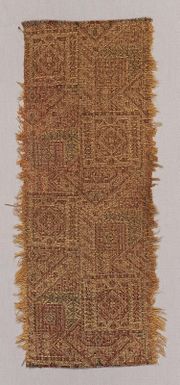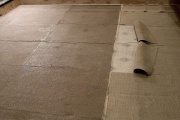Difference between revisions of "Jute"
| Line 24: | Line 24: | ||
Combustible. Poor resistance to sunlight, microorganisms and insects. Deteriorates rapidly when wet. | Combustible. Poor resistance to sunlight, microorganisms and insects. Deteriorates rapidly when wet. | ||
| − | |||
| − | |||
| − | |||
== Comparisons == | == Comparisons == | ||
[[media:download_file_153.pdf|Properties of Natural Fibers]] | [[media:download_file_153.pdf|Properties of Natural Fibers]] | ||
| − | + | [[File:1.21.2005 04-Facing removed.jpg|thumb|Facing removed | |
| − | + | [[File:Jute40x.jpg|thumb|Jute fibers stained with Graff "C" stain | |
| − | |||
| − | |||
| − | |||
| − | |||
| − | File:1.21.2005 04-Facing removed.jpg|Facing removed | ||
| − | File:Jute40x.jpg|Jute fibers stained with Graff "C" stain | ||
| − | |||
== Authority == | == Authority == | ||
Revision as of 14:01, 25 June 2020
Description
Long bast fibers obtained from the stems of linden plants, Corchorus capsularis (white jute) or Corchorus olitorius (Tossa jute). Jute probably originated in the Mediterranean region and was taken to India and southeast Asia where it flourished. Jute has been used by man since prehistoric times. The pale brown fibers are soft, lustrous, and coarse ranging in length from 4 to 10 feet. Microscopically, the fibers exhibit irregular, long cells with a visible lumen. Jute is composed of Cellulose (69%), Lignin (18-20%) with some uronic anhydride (4.5%). The brittle fibers are used to produce a thread called hessian. Jute becomes so weak when wet that a thin twine can be broken by hand. It turns brown and degrades with time, sunlight, Water, acids, alkalis, and bleach. Jute is used to make sackcloth, burlap cloth, gunnysacks, Twine, Paper, and Carpet backing. It was also used to make brown paper in Europe in the mid-19th century.
See also Brazilian jute, Paco-paco, pita, and Curana.
Synonyms and Related Terms
Corchorus capsularis; juta (It., Port.); Huang-ma (Chin.); Jutefaser (Deut.); yute (Esp.); jute (Ned); Tossa jute; white jute; Indian jute; hessian; Bengal hemp; Calcutta hemp; allyott;
Other Properties
Resistant to alkalis and dilute acids. Degraded by concentrated acids.
Fiber length = 1.5-3.0 m; Fiber width = 7-18 microns; cross section = polygonal with 5 or 6 sides. Moisture regain = 13.75%; Elongation = 1.7% (dry); Striations tend to be fine and often stop in the middle of the fiber; Fibers often are found in bundles. Density = 1.5
Paper fiber type: Non-woody/bast. Using transmitted light microscopy, fibers appear short and narrow with thick walls. Dislocations are present but faint. The ends of fibers can be spoon-shaped with widened lumen. Appearance with Graff "C" stain: Orange-red, but greys with bleaching. Average dimensions of fibers: length, 2mm, width 20μm. Common pulping method: soda.
Hazards and Safety
Combustible. Poor resistance to sunlight, microorganisms and insects. Deteriorates rapidly when wet.
Comparisons
Properties of Natural Fibers [[File:1.21.2005 04-Facing removed.jpg|thumb|Facing removed [[File:Jute40x.jpg|thumb|Jute fibers stained with Graff "C" stain
Authority
- D. Catling, J. Grayson, Identification of Vegetable Fibres, Archetype Publications, London, 1998.
- G.Cook, Handbook of Textile Fibres:I. Natural Fibres, 5th edition, Merrow Publishing Co., Durham, England, 1984.
- T.Collings, D. Miller, 'The Identification of Oriental Paper Fibers' The Paper Conservator, vol 3, 1978.
- Hoechst Celanese Corporation, Dictionary of Fiber & Textile Technology (older version called Man-made Fiber and Textile Dictionary, 1965), Hoechst Celanese Corporation, Charlotte NC, 1990
- Marja-Sisko Ilvessalo-Pfäffli. Fiber Atlas: Identification of Papermaking Fibers (Springer Series in Wood Science). Springer, 1995.
- Rosalie Rosso King, Textile Identification, Conservation, and Preservation, Noyes Publications, Park Ridge, NJ, 1985
- Marjory L. Joseph, Introductory Textile Science, Holt, Rinehart and Winston, Fort Worth, TX, 1986
- R. J. Gettens, G.L. Stout, Painting Materials, A Short Encyclopaedia, Dover Publications, New York, 1966
- Reed Kay, The Painter's Guide To Studio Methods and Materials, Prentice-Hall, Inc., Englewood Cliffs, NJ, 1983
- Henry Hodges, Artifacts: An Introduction to Early Materials and Technology, Ronald P. Frye, Kingston, Canada, 1988
- A.Lucas, J.R.Harris, Ancient Egyptian Materials and Industries, Edward Arnold Publishers Ltd., London, 4th edition, 1962
- Identification of Textile Materials, The Textile Institute, Manchester, England, 1985
- Encyclopedia Britannica, http://www.britannica.com Comment: "jute" [Accessed October 18, 2001].-
- Wikipedia: http://en.wikipedia.org/wiki/Jute (Accessed Mar. 20, 2006)
- Matt Roberts, Don Etherington, Bookbinding and the Conservation of Books: a Dictionary of Descriptive Terminology, U.S. Government Printing Office, Washington DC, 1982
- G.S.Brady, Materials Handbook, McGraw-Hill Book Co., New York, 1971 Comment: p. 426
- Book and Paper Group, Paper Conservation Catalog, AIC, 1984, 1989
- Richard S. Lewis, Hawley's Condensed Chemical Dictionary, Van Nostrand Reinhold, New York, 10th ed., 1993
- Walter Rantanen. "Fiber ID Course." Integrated Paper Services. June 2013. Lecture.
- Random House, Webster's Encyclopedic Unabridged Dictionary of the English Language, Grammercy Book, New York, 1997
- The American Heritage Dictionary or Encarta, via Microsoft Bookshelf 98, Microsoft Corp., 1998
- Art and Architecture Thesaurus Online, http://www.getty.edu/research/tools/vocabulary/aat/, J. Paul Getty Trust, Los Angeles, 2000



